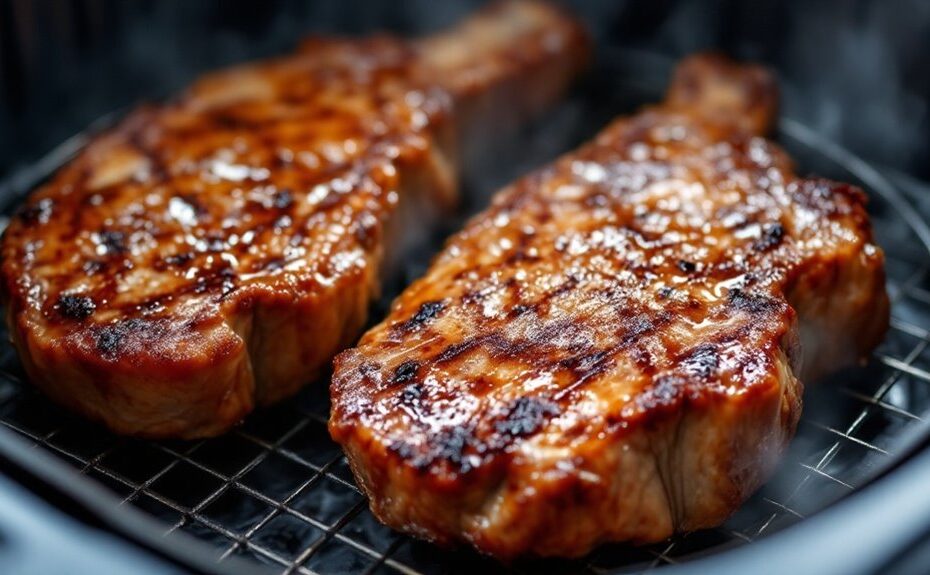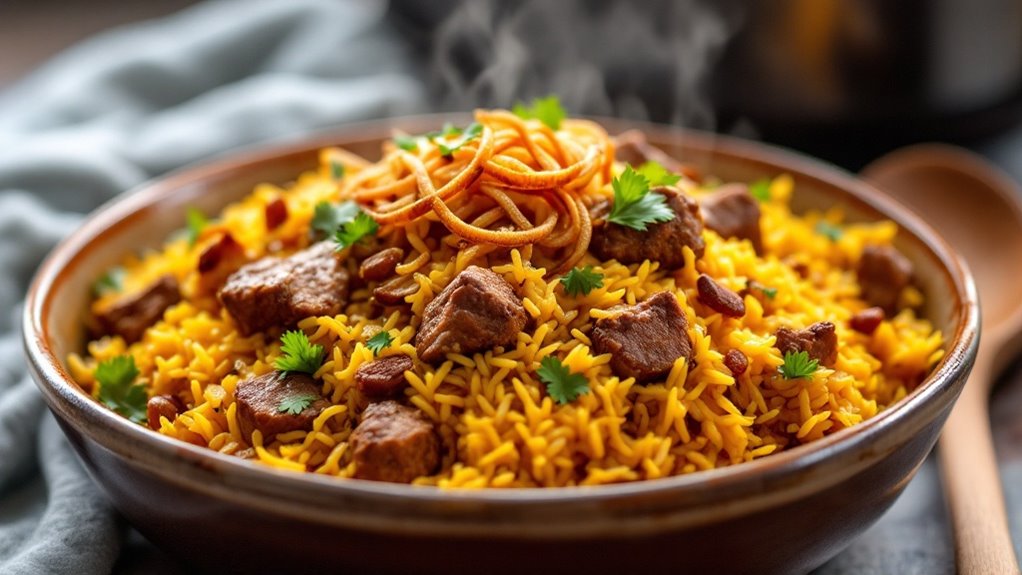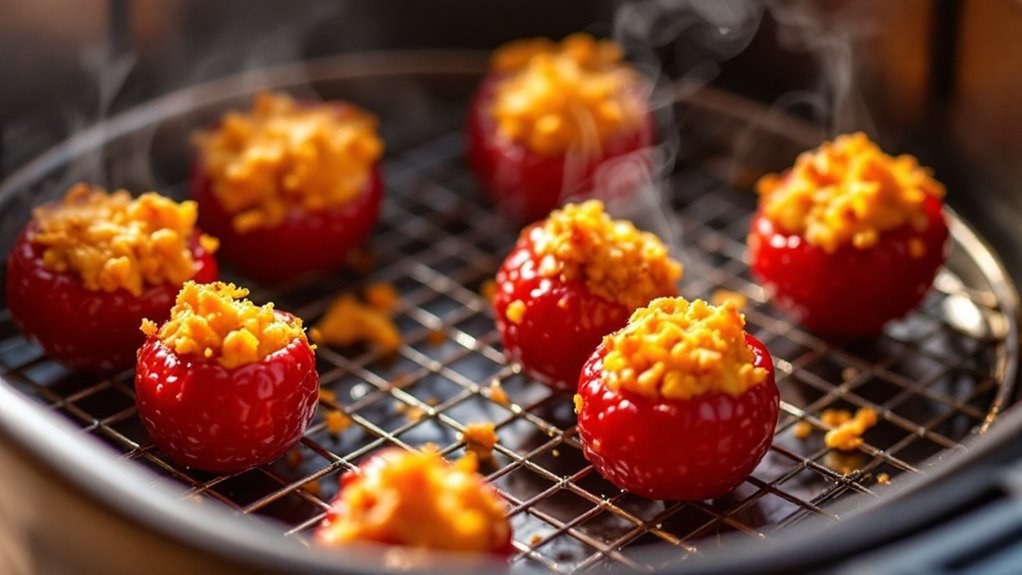Making air fryer bison steaks starts with choosing the right cut—opt for ribeye or sirloin with good marbling. You'll need to pat the steaks dry, season them generously, and let them rest to enhance flavor. Preheat your air fryer to 400°F, but the real trick lies in timing and temperature control. Cook them for 4-6 minutes per side, aiming for medium-rare at 130°F. Resting the steaks afterward is essential, but what happens next could elevate your dish to something unforgettable. The key might surprise you, and it's simpler than you think.
Key Takeaways
- Select well-marbled bison steaks (1-1.5 inches thick) and pat dry for better searing.
- Season with a spice rub and let rest at room temperature for 20-30 minutes before cooking.
- Preheat air fryer to 400°F (204°C) and cook steaks for 4-6 minutes per side, flipping halfway.
- Check doneness with a meat thermometer: 130°F for medium-rare, 140°F for medium.
- Rest steaks for 5-10 minutes before serving to allow juices to redistribute for maximum tenderness.
Choosing the Right Bison Steaks
When selecting bison steaks for air frying, opt for cuts that are well-marbled and evenly thick, as they'll cook more consistently and retain moisture. Focus on bison selection by choosing ribeye, strip, or sirloin cuts, which are ideal for air frying due to their balance of tenderness and flavor. Make sure the steak thickness is uniform, ideally between 1 to 1.5 inches, to prevent uneven cooking. Thicker cuts may require longer cooking times, while thinner ones risk overcooking. Avoid steaks with excessive connective tissue, as they can become tough when air-fried. Inspect the meat for bright red color and firm texture, indicators of freshness. Proper bison selection and attention to steak thickness will set the foundation for a perfectly cooked, juicy steak in your air fryer.
Preparing the Steaks for Cooking
Before air frying, pat the bison steaks dry with paper towels to remove excess moisture, guaranteeing a better sear. Check the meat thickness, as it determines cooking time; aim for steaks around 1 to 1.5 inches thick for even cooking. If marinating, allow the steaks to rest in the marinade for at least 30 minutes, though 2-4 hours enhances flavor penetration. Avoid over-marinating, as bison's lean nature can make it overly tender. After marinating, let the steaks sit at room temperature for 20-30 minutes to guarantee even cooking. Trim any excess fat or silver skin to prevent uneven texture. Arrange the steaks on a clean surface, making sure they're not overcrowded, and prepare them for seasoning or immediate cooking. Proper preparation guarantees the best possible results in the air fryer.
Seasoning Your Bison Steaks
Seasoning bison steaks properly enhances their natural flavor while complementing their lean texture. Start by patting the steaks dry with paper towels to guarantee the seasoning adheres well. Generously coat both sides with a high-quality spice rub or herb blend, focusing on flavors like garlic, rosemary, thyme, or smoked paprika to complement the meat's richness. For a balanced profile, combine kosher salt, freshly ground black pepper, and a touch of cayenne for heat. Massage the rub into the surface, making sure of even coverage. Let the steaks rest for 10–15 minutes to allow the flavors to penetrate. Avoid over-seasoning, as bison's delicate taste can be overwhelmed. Experiment with pre-made herb blends or create your own to tailor the seasoning to your preferences.
Preheating the Air Fryer
Set your air fryer to 400°F, the ideal temperature for searing bison steaks while locking in moisture. Allow the unit to preheat for 3-5 minutes, ensuring the heating element and fan reach full operational capacity. This step guarantees even heat distribution, which is critical for achieving consistent cooking results.
Optimal Temperature Setting
To achieve the best results when cooking bison steaks in an air fryer, preheat the appliance to 400°F (204°C) for approximately 3–5 minutes. This guarantees temperature accuracy, which is critical for even cooking and achieving the desired doneness. Set the air fryer to its highest temperature setting to maintain heat consistency throughout the cooking process. Verify the temperature using the appliance's built-in thermometer or an external one if available. Avoid opening the air fryer during preheating, as this disrupts heat consistency and prolongs the process. A properly preheated air fryer creates a sear on the bison steaks, locking in juices and enhancing flavor. Make sure the basket is empty during preheating to allow ideal airflow and uniform heat distribution, which is essential for achieving a perfectly cooked steak.
Preheating Time Duration
While preheating the air fryer is a critical step for ideal cooking, it typically takes 3–5 minutes at 400°F (204°C) to reach the desired temperature. Preheating benefits include guaranteeing consistent cooking and achieving a seared exterior on your bison steaks. To save time, start preheating as soon as you've seasoned your steaks, allowing the air fryer to heat while you prepare. Use the preheating indicator light or timer on your air fryer to confirm readiness. Avoid opening the basket during this process to maintain heat efficiency. If your air fryer lacks a preheat function, manually set the timer for 3–5 minutes at the target temperature. This step secures the cooking chamber is evenly heated, reducing the risk of undercooked or unevenly cooked steaks.
Ensuring Even Heat Distribution
Since even heat distribution is essential for perfectly cooked bison steaks, preheating the air fryer guarantees the cooking chamber reaches a uniform temperature before you begin. Set your air fryer to the desired temperature, typically 400°F, and allow it to preheat for 3-5 minutes. This step secures consistent heat circulation tips are applied, preventing cold spots that could lead to uneven cooking. Proper airflow management techniques are also critical; avoid overcrowding the basket to maintain ideal air movement around the steaks. Arrange the bison steaks in a single layer, leaving space between each piece. If cooking multiple batches, re-preheat the air fryer briefly between cycles to restore the perfect cooking environment. These steps secure even heat distribution, resulting in perfectly seared and tender bison steaks.
Cooking the Bison Steaks
Preheat your air fryer to 400°F (204°C) to guarantee it reaches the ideal temperature for searing the bison steaks. Lightly pat the steaks dry with a paper towel to remove excess moisture, ensuring a proper sear. Place the steaks in the air fryer basket, leaving space between them for even airflow. Cook for 4-6 minutes per side, adjusting based on steak thickness considerations—thicker cuts may require additional time. If you've followed bison marination tips, the flavors will intensify during cooking. Avoid overcrowding the basket, as this can lead to uneven cooking. Use tongs to flip the steaks halfway through, ensuring both sides develop a rich, caramelized crust. Monitor the cooking process closely, as bison cooks faster than beef due to its leaner composition.
Checking for Doneness
Use an instant-read meat thermometer to check the internal temperature of the bison steaks, aiming for 130°F for medium-rare or 140°F for medium. Assess the steaks' doneness by observing their firmness; they should feel slightly springy when pressed with tongs or a finger. Look for a golden-brown crust and clear, reddish-pink juices to confirm proper cooking.
Internal Temperature Check
To guarantee your bison steaks reach the desired doneness, insert an instant-read meat thermometer into the thickest part of the steak, avoiding bones or fat. Proper thermometer placement secures temperature accuracy, which is critical for achieving consistent results. For rare, aim for 120-125°F; medium-rare, 130-135°F; medium, 140-145°F; medium-well, 150-155°F; and well-done, 160°F or higher. Bison cooks faster than beef, so monitor closely to prevent overcooking. Confirm the thermometer tip is centered in the meat's thickest section for an accurate reading. Avoid touching the air fryer basket or pan, as this can skew results. Remove the steak 5°F below your target temperature, as residual heat will carry it to the final doneness. Rest the steak for 5-10 minutes before serving to allow juices to redistribute.
Visual and Texture Cues
While a meat thermometer provides precise temperature readings, visual and texture cues are equally important for determining doneness. Observe the steak's surface for color changes; bison steaks shift from a deep red to a rich brown as they cook. The exterior should develop a caramelized crust, signaling proper searing. Press the steak gently with tongs or a spatula to assess texture changes. Rare steaks feel soft and springy, while medium steaks offer slight resistance. Well-done steaks feel firm. Additionally, check for juices; clear or light pink juices indicate doneness, while red juices suggest the steak needs more time. Combine these cues with internal temperature readings to confirm your bison steak is cooked to your desired level. This dual approach guarantees both safety and peak flavor.
Resting the Steaks After Cooking
After removing the bison steaks from the air fryer, let them rest on a cutting board or plate for 5–10 minutes. This step is vital for achieving the resting benefits, as it allows the juices to redistribute evenly throughout the meat. If you slice the steaks immediately, the juices will escape, resulting in a drier texture. Resting also enhances meat tenderness by giving the muscle fibers time to relax after cooking. Cover the steaks loosely with aluminum foil to retain warmth without trapping steam, which can soften the crust. Avoid pressing or cutting into the steaks during this period to preserve their juiciness. Proper resting guarantees a more flavorful and tender bite, making it an essential step in preparing bison steaks.
Serving Suggestions for Bison Steaks
When serving bison steaks, pair them with complementary sides and sauces to enhance their rich, slightly sweet flavor. Opt for roasted vegetables like asparagus or Brussels sprouts, or creamy mashed potatoes to balance the steak's lean texture. A tangy chimichurri or red wine reduction sauce adds depth without overpowering the meat. For wine pairings, choose a medium-bodied red like Syrah or Pinot Noir, which complements the steak's robust flavor. If you prefer white wine, a Chardonnay with buttery notes works well. Garnish with fresh herbs like thyme or rosemary for an aromatic finish. Serve the steaks sliced against the grain to guarantee tenderness, and arrange them alongside your chosen side dishes for a visually appealing and flavorful meal.
Cleaning and Maintaining Your Air Fryer
To maintain your air fryer's peak performance, it's essential to clean it thoroughly after each use. Start by unplugging the appliance and allowing it to cool completely. Remove the basket, tray, and any removable parts, then wash them with warm, soapy water. Use a non-abrasive sponge to avoid scratching surfaces. Wipe the interior and exterior with a damp cloth, ensuring no food residue remains. For stubborn grease, apply a baking soda paste and rinse thoroughly. Check the heating element for debris and clean it gently with a soft brush. Follow maintenance tips like inspecting the power cord for damage and ensuring vents are unobstructed. Adhere to a consistent cleaning frequency to prevent buildup and extend the air fryer's lifespan. Always dry components fully before reassembling.
Disclosure: As an Amazon Associate, I earn from qualifying purchases.



